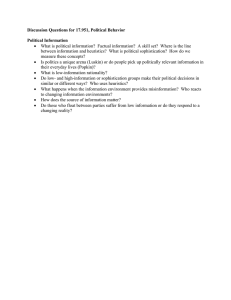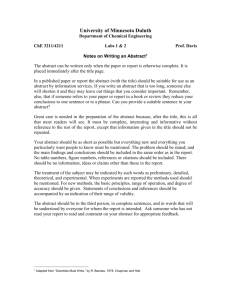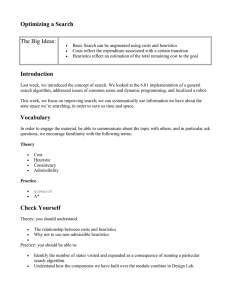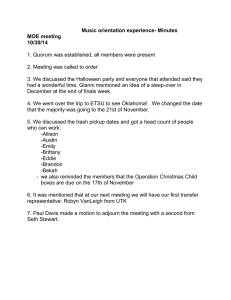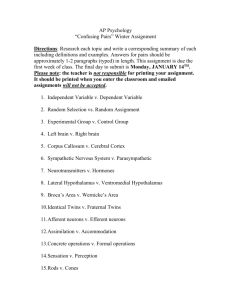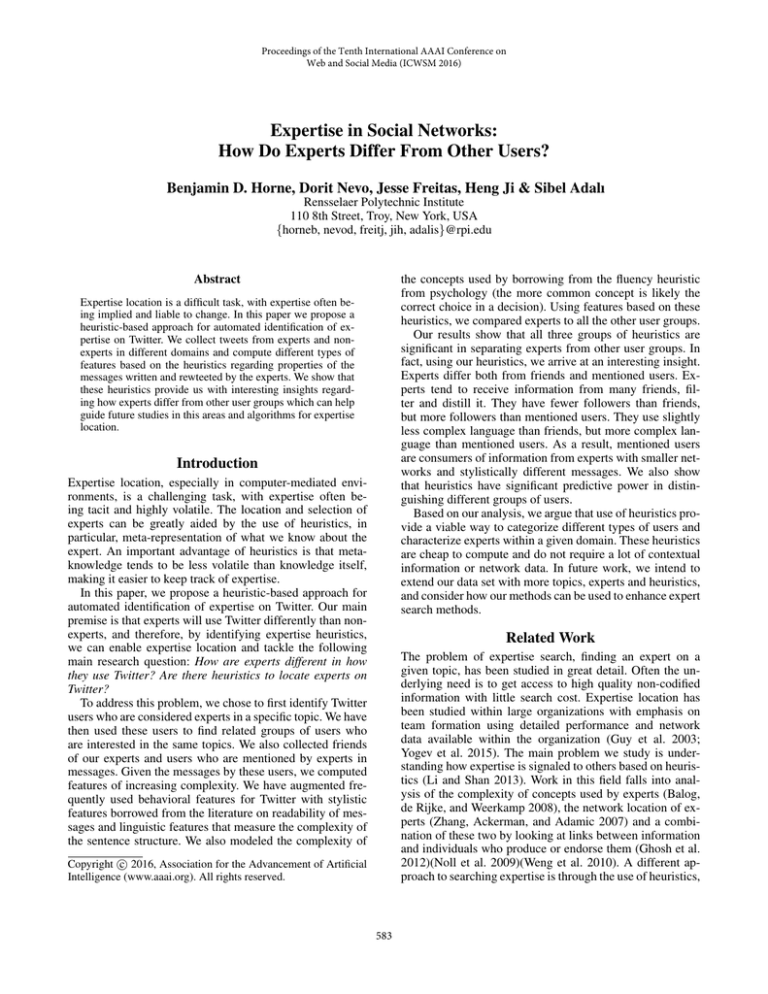
Proceedings of the Tenth International AAAI Conference on
Web and Social Media (ICWSM 2016)
Expertise in Social Networks:
How Do Experts Differ From Other Users?
Benjamin D. Horne, Dorit Nevo, Jesse Freitas, Heng Ji & Sibel Adalı
Rensselaer Polytechnic Institute
110 8th Street, Troy, New York, USA
{horneb, nevod, freitj, jih, adalis}@rpi.edu
the concepts used by borrowing from the fluency heuristic
from psychology (the more common concept is likely the
correct choice in a decision). Using features based on these
heuristics, we compared experts to all the other user groups.
Our results show that all three groups of heuristics are
significant in separating experts from other user groups. In
fact, using our heuristics, we arrive at an interesting insight.
Experts differ both from friends and mentioned users. Experts tend to receive information from many friends, filter and distill it. They have fewer followers than friends,
but more followers than mentioned users. They use slightly
less complex language than friends, but more complex language than mentioned users. As a result, mentioned users
are consumers of information from experts with smaller networks and stylistically different messages. We also show
that heuristics have significant predictive power in distinguishing different groups of users.
Based on our analysis, we argue that use of heuristics provide a viable way to categorize different types of users and
characterize experts within a given domain. These heuristics
are cheap to compute and do not require a lot of contextual
information or network data. In future work, we intend to
extend our data set with more topics, experts and heuristics,
and consider how our methods can be used to enhance expert
search methods.
Abstract
Expertise location is a difficult task, with expertise often being implied and liable to change. In this paper we propose a
heuristic-based approach for automated identification of expertise on Twitter. We collect tweets from experts and nonexperts in different domains and compute different types of
features based on the heuristics regarding properties of the
messages written and rewteeted by the experts. We show that
these heuristics provide us with interesting insights regarding how experts differ from other user groups which can help
guide future studies in this areas and algorithms for expertise
location.
Introduction
Expertise location, especially in computer-mediated environments, is a challenging task, with expertise often being tacit and highly volatile. The location and selection of
experts can be greatly aided by the use of heuristics, in
particular, meta-representation of what we know about the
expert. An important advantage of heuristics is that metaknowledge tends to be less volatile than knowledge itself,
making it easier to keep track of expertise.
In this paper, we propose a heuristic-based approach for
automated identification of expertise on Twitter. Our main
premise is that experts will use Twitter differently than nonexperts, and therefore, by identifying expertise heuristics,
we can enable expertise location and tackle the following
main research question: How are experts different in how
they use Twitter? Are there heuristics to locate experts on
Twitter?
To address this problem, we chose to first identify Twitter
users who are considered experts in a specific topic. We have
then used these users to find related groups of users who
are interested in the same topics. We also collected friends
of our experts and users who are mentioned by experts in
messages. Given the messages by these users, we computed
features of increasing complexity. We have augmented frequently used behavioral features for Twitter with stylistic
features borrowed from the literature on readability of messages and linguistic features that measure the complexity of
the sentence structure. We also modeled the complexity of
Related Work
The problem of expertise search, finding an expert on a
given topic, has been studied in great detail. Often the underlying need is to get access to high quality non-codified
information with little search cost. Expertise location has
been studied within large organizations with emphasis on
team formation using detailed performance and network
data available within the organization (Guy et al. 2003;
Yogev et al. 2015). The main problem we study is understanding how expertise is signaled to others based on heuristics (Li and Shan 2013). Work in this field falls into analysis of the complexity of concepts used by experts (Balog,
de Rijke, and Weerkamp 2008), the network location of experts (Zhang, Ackerman, and Adamic 2007) and a combination of these two by looking at links between information
and individuals who produce or endorse them (Ghosh et al.
2012)(Noll et al. 2009)(Weng et al. 2010). A different approach to searching expertise is through the use of heuristics,
c 2016, Association for the Advancement of Artificial
Copyright Intelligence (www.aaai.org). All rights reserved.
583
Table 1: Resources used to locate experts
Topic
Science
Technology
Technology
Health
Health
Health
Business
Resource
http://www.teachthought.com/learning/100-scientists-on-twitter-by-category/
http://www.hashtags.org/entertainment/celebrities/10-tech-experts-you-should-follow-on-twitter/
http://www.yfncg.com/2009/05/11/100-tech-twitter-accounts/
http://diettogo.com/blog/15-health-and-wellness-experts-you-should-be-following
http://greatist.com/health/must-follow-health-and-fitness-twitter-accounts-2012
http://www.stack.com/a/twitter-fitness-experts
http://www.huffingtonpost.com/vala-afshar/twitter-business-tech_b_2355700.html
rules of thumb used to support decision making, which have
been acknowledged as useful in expertise location (Nevo,
Benbasat, and Wand 2012). Despite this increased focus on
their role and importance, little empirical work exists that
identifies which heuristics are relevant in locating expertise.
Aiming to close this gap, we identify expertise heuristics on
social media that can be used to support the location of expertise.
short messages encountered on Twitter. We also extracted
linguistic features to measure the complexity of the sentences and the concept, which are first computed for each
message of the user and then averaged over all their messages. All features were computed first for original messages by the users only. We also compute a second set of
features for the messages retweeted by the users. This second set is analyzed separately. The final dataset with the features for all different user groups is available at:https:
//github.com/rpitrust/expertisedataset.
Data were analyzed using simple logistic regression with
the dependent variable being the group membership of users.
To tease out difference between the experts group and all
other groups we opted to compute separate pairwise binary
models comparing comparing experts to friends, experts to
users mentioned by them, and experts to the medium hashtag group. Data were cleaned to eliminate missing values
and any highly correlated features. We used the log of followers, friends, and number of tweets to reduce the impact
of outliers. We conducted this analysis first for original messages and then for retweeted messages, (Tables 3 (a) and (b)
respectively) and also show general descriptive of the distribution of feature values across groups in Figure 1.
Methods
We first identified a set of experts by using the the social
acclamation approach, relying on the identification of experts by others in their field (Shanteau et al. 2002) and viewing recognition by others in this field “as having the necessary skills and abilities to perform at the highest level”. We
collected tweets from experts in four topics, Science, Technology, Health&Fitness and Business using online sources
given in Table 1. We manually chose all the active users from
these lists with at least 1000 messages who mainly post in
English.
Then, we used a hierarchical sampling method to find
users who are interested in the same topics by finding the
last (up to 3200) messages by our experts. We then found
users mentioned by experts in their messages and also users
followed by experts (friend). We then found the commonly
used hashtags by the experts each group (excluding common
non-domain tags, about 70 hashtags for each domain) and
collected users who used the same hashtags. We grouped
these users into low/medium/high hashtag usage based on
the statistical distribution of usage. We included the middle
range, mediumtag in our analysis and excluded the others
as outliers. For each of our four sets of users, we collected
messages using the Twitter streaming API for a period of 3
months.
We collected three basic types of features for the messages collected for each user, shown in Table 2. We concentrated on heuristics that are relatively simple to compute
and would work with limited or incomplete data. These features do not require large scale collection of network or topic
based data. The behavioral features use very little semantic
analysis. The last three features in this set are normalized
to the energy of individuals, while the first four features are
global and are used in the log scale.
The stylistic features are based on deeper natural language processing of the sentence structure and grammatical elements, borrowing from the work on readability analysis (Feng et al. 2010) with the hypothesis that experts produce messages that are more readable by a large audience.
We restricted our features to those that work well for the
Results and Conclusions
We find that the number of years a user has been in Twitter,
number of friends and number of followers are always significant in distinguishing experts for original messages. We
included them in our analysis of retweeted messages as a
control. Overall, all three types of heuristics are useful in
identifying experts both original and retweeted messages,
however fewer heuristics are effective in distinguishing the
types of messages retweeted by experts.
We note that experts tend to be older Twitter users than the
other groups, partially due to bias in our data. As our data is
based on peer judgments, the likelihood of being known by
others’ is higher for older Twitter users. Despite this fact,
experts tend to follow more users, but have fewer followers
than their friends. In essence, one can view friends of experts
as news sources that experts collect information from. Experts distill this information and produce their own opinion.
This means that experts’ friends are not necessarily experts.
This trend is reversed for mentioned friends: experts have
more followers and follow more users than mentioned users.
In other words, mentioned users are consumers of information provided by experts. Mentioned users serve smaller
and possibly different communities. Experts sit between the
two groups of users: information publishers and information consumers, reducing and interpreting information be-
584
Table 2: Different features used in our study
Abbr.
Description
friends
# friends (log scale)
followers
# followers (log scale)
total tweets # tweets in Twitter (log scale)
years
# years a user has been on Twitter
mentpermsg # mentions per original msg
tagpermsg # hashtags per original msg
urlpermsg # urls per original msg
% msgs that are original (not retweet)
p org
p msgwment % of msgs with at least one mention
p msgwtag % of msgs with at least one hashtag
p msgwurl % of msgs with at least one url
Abbr.
char
punc
comma
period
quesmark
exmark
semi
colon
first
vp
np
interj
stop
slang
senti
entity
dt
modal
neg
active
(a) Behavioral Features
org med d median depth of syntax tree
org med d npmedian depth of noun phrase tree
org med d vpmedian depth of verb phrase tree
lexco
user’s lexical coherence
frequency of least common word used
flu min
avg. frequency of least common 3 words
flu min3
Description
# chars
# punctions
# commas
# periods
# question marks
# exclamation mark
# semicolon
# colon
# first person terms
# verb phrases
# noun phrases
# interjections (e.g. yeah, uh)
# stop words (e.g. a, the, to)
# slang terms (e.g. omg, :))
# sentiment terms
# entities
# definite articles (e.g. the, those, ..)
# modal verbs (e.g. may, should, could)
# negative verbs (e.g. never, cannot)
# active verbs (i.e. not passive tense)
(c) Stylistic Features
(b) Linguistic Features
Figure 1: 95% Confidence Interval of the four behavioral features for different user groups.
tween them. The semantic features shows that experts use
slightly less specialized language (flu min) and simpler sentences (org med d vp) than friends, but significantly more
specialized language than mentioned users (flu min). Mentioned users have a great deal of stylistic differences than experts: they use fewer commas and exclamation points, more
slang and refer to more entities. The mediumtag group resembles the mentioned user group, but has fewer characteristic stylistic features than mentioned group. Other differences are amplified. We have found that experts in our group
are not heavy users of hashtags and neither are the friends.
The tag usage increases from experts to mentioned users,
and also from mentioned users to the users in the medium
tag group.
Retweeted messages of experts, friends and mentioned
users are more similar to each other than hashtag users, partially due to our sampling methodology that favored users
connected to each other. Despite this similarity, experts
retweet longer messages than their friends likely containing many short URLs common to news sources. Similarly,
experts tend to retweet messages that contain more complex
sentences (org med d np) than their friends and mentioned
users.
Since we are working with a relatively small group of experts in our data set, we did not partition it for both training
and testing. We used the group of users who were mentioned
by the experts (n= 1000) and separated 300 random users
as test group. As a second group (non-mentioned), we took
a random sample of equal size to our test group from the
medium hashtags users. We again developed a logistic regression model to estimate the likelihood of falling in the
mentioned group, using our training data. We then used this
model to make a prediction using the testing data. Our model
proved to be very good at predicting the likelihood of a person falling in the mentioned group as opposed to the hashtag group, with an 80.5% accuracy.This prediction was made
solely based on the features collected and discussed in this
paper.
Our results show that heuristics can be used to help distinguish users who are perceived to be experts by others. Our
585
Table 3: Significant features that distinguish experts from user groups: B: behavioral, S: stylistic and L: linguistic. A positive
sign means a high value increases the likelihood that the user is an expert and a negative sign means a high value decreases the
likelihood the user is an expert (significance codes: 0 (***) 0.001 (**) 0.01 (*) 0.05 (.) 0.1).
Type
B
B
B
B
B
B
B
S
S
S
S
S
S
S
S
S
L
L
L
Feature
total tweets
friends
followers
years
p msgwment
p msgwtag
p org
char
comma
exmark
punc
interj
slang
np
entity
active
org med d np
org med d vp
flu min
friend
+**
+***
−**
+***
+*
+**
+.
User Groups
mentioned mediumtag
−.
+***
+***
+**
−.
+***
+***
+***
−**
−***
+*
+*
−**
−**
−*
−.
−.
+.
−**
+**
+*
+.
−**
(a) Features computed from original messages
Feature
total tweets
friends
followers
years
p msgwment
p msgwtag
p org
char
comma
exmark
punc
interj
slang
np
entity
active
org med d np
org med d vp
flu min
friend
+.
+***
+***
+***
User Groups
mentioned mediumtag
+*
+***
+*
+***
+***
+***
+***
+*
−*
+*
−*
+*
+**
+.
+*
+**
−**
+.
+**
+.
+.
+.
(b) Features computed from retweeted messages
heuristics further show that experts consume information
from friends and feed it to other users, such as users mentioned by them. Understanding the significant differences
between users groups we found and using them in designing
more refined expertise search methods is part of our future
research.
Li, C. T., and Shan, M. K. 2013. X2-search: Contextual
expert search in social networks. In TAAI, 176–181.
Nevo, D.; Benbasat, I.; and Wand, Y. 2012. Understanding
technology support for organizational transactive memory:
Requirements, application, and customization. Journal of
Management Information Systems 28(4):69–98.
Noll, M.; Yeung, A.; Gibbins, N.; Meinel, C.; and Shadbolt,
N. 2009. Telling experts from spammers: expertise ranking
in folksonomies. In SIGIR, 612–619.
Shanteau, J.; Weiss, D.; Thomas, R.; and Pounds, J. 2002.
Performance-based assessment of expertise: How to decide
if someone is an expert or not. European Journal of Operational Research 136(2):253–263.
Weng, J.; Lim, E. P.; Jiang, J.; and He, Q. 2010. Twitterrank:
Finding topic-sensitive influential twitterers. In WSDM.
Yogev, A.; Guy, I.; Ronen, I.; Zwerdling, N.; and Barnea, M.
2015. Social media-based expertise evidence. In ECSCW.
Springer International Publishing. 63–82.
Zhang, J.; Ackerman, M.; and Adamic, L. 2007. Expertise
networks in online communities: structure and algorithms.
In WWW, 221–230.
Acknowledgments
Research was sponsored by the Army Research Laboratory
and was accomplished under Cooperative Agreement Number
W911NF-09-2-0053 (the ARL Network Science CTA). The views
and conclusions contained in this document are those of the authors
and should not be interpreted as representing the official policies,
either expressed or implied, of the Army Research Laboratory or
the U.S. Government. The U.S. Government is authorized to reproduce and distribute reprints for Government purposes notwithstanding any copyright notation here on.
References
Balog, K.; de Rijke, M.; and Weerkamp, W. 2008. Bloggers
as experts: feed distillation using expert retrieval models. In
SIGIR, 753–754.
Feng, L.; Jansche, M.; Huenerfauth, M.; and Elhadad, N.
2010. A comparison of features for automatic readability
assessment. In COLING, 276–284.
Ghosh, S.; Sharma, N.; Benevenuto, F.; Ganguly, N.; and
Gummadi, K. P. 2012. Cognos: crowdsourcing search for
topic experts in microblogs. In SIGIR.
Guy, I.; Avraham, U.; Carmel, D.; Ur, S.; Jacovi, M.; and
Ronen, I. 2003. Mining expertise and interests from social
media. In WWW, 515–526.
586



